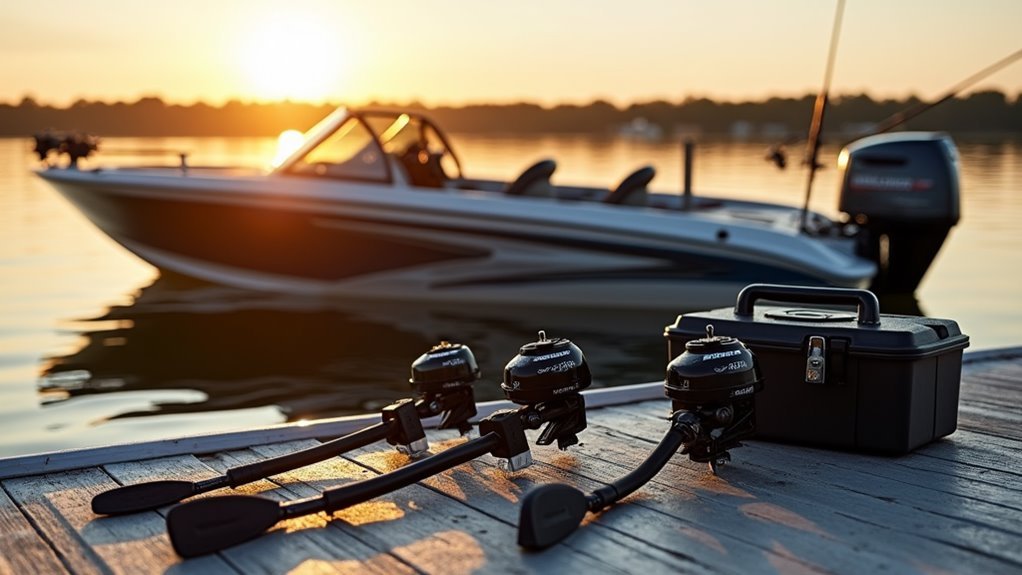Last weekend, Mike discovered his new trolling motor wasn't performing well because he'd chosen the wrong shaft length – a common mistake that can lead to poor control and wasted money. We'll help you avoid this frustrating situation by exploring how to measure and select the perfect length for your boat. Whether you're mounting on the bow or transom, we've got the essential tips to guarantee your motor stays properly submerged and functions at its best in any water conditions.
Essential Measurements for Proper Shaft Selection
When it comes to selecting the right trolling motor shaft length, taking accurate measurements is absolutely critical for your boat's performance.
We'll help you figure out the perfect shaft length by measuring from your mounting surface to the water line. For bow mounted trolling motors, if you've got a bow to water line measurement up to 22 inches, you'll want a 36-inch shaft.
Need something longer? Measurements between 28-34 inches call for a 54-62 inch shaft.
Remember to add 20-25 inches in freshwater or 25-30 inches in saltwater for peak performance. Your prop needs to stay at least 12 inches below the water line to prevent problems, so getting these measurements right will keep you cruising smoothly without any power-robbing cavitation.
Bow Mount Vs Transom Mount Length Requirements
Since your trolling motor's mounting location affects its required shaft length, understanding the specific needs for bow versus transom mounts is essential for peak performance.
For bow mounts, we'll need to add 20-30 inches to the distance from the mounting surface to the waterline. If your bow-to-water measurement is 10-16 inches, you'll want a 36-inch shaft, while 22-28 inches calls for a 45-52 inch shaft.
Transom mount requirements are a bit different. We'll add 20 inches to your transom-to-waterline measurement to find the right shaft length.
Common shaft lengths for transom mounts typically range from 30 to 42 inches. Remember, getting the length right is vital – too short causes poor performance, while longer shafts give you better control in rough water.
Water Conditions and Their Impact on Shaft Length

The water conditions you'll encounter play a crucial role in determining the right shaft length for your trolling motor.
When you're planning for offshore fishing or rough waters, proper shaft length becomes even more essential for maintaining control and performance.
Here's what you need to take into account for different water conditions:
- For freshwater lakes and calm conditions, add 20-22 inches to your bow-to-waterline measurement.
- In saltwater environments, extend the length by 25 inches to handle increased wave action.
- For offshore fishing or turbulent waters, plan for 27-30 inches extra length.
- Always maintain at least 12 inches below waterline for best performance.
We've found that going with a longer shaft gives you more stability and better thrust in challenging conditions.
It's worth the extra investment to guarantee your trolling motor stays properly submerged, especially when the waters get rough.
Common Mistakes in Shaft Length Determination
Despite proper planning for water conditions, many boaters still end up with the wrong shaft length for their trolling motor.
Let's look at the most common mistakes we've seen and how to avoid them. First, many of us forget to factor in bow rise when measuring, which means the shaft would end up too short.
We also need to remember to add the recommended 20-30 inches beyond our initial measurements to keep the motor head properly submerged in choppy waters.
Another mistake we often make is measuring from the wrong point on the transom, and not considering how boat loading affects the waterline.
To get it right, we should always check our manufacturer's guidelines and account for specific mounting requirements.
Advanced Sizing Tips for Different Boat Types

When choosing a trolling motor shaft length, different boat types require specific attention to detail.
We've found that getting the right measurement is vital for peak performance on the water.
Let's look at some key guidelines for different vessels:
- Small to medium boats: Measure bow to waterline, then add 20-22 inches for your rated shaft length.
- Offshore vessels over 22 feet: Add 30-40 inches to your bow measurement for proper depth.
- Transom mount setups: With 16-22 inches from transom to water, go for a 42-inch shaft.
- Rough water boats: Choose longer than standard measurements, ensuring at least 12 inches below waterline.
Frequently Asked Questions
Can a Trolling Motor Be Too Deep?
Yes, we've found that excessive trolling motor depth causes increased water resistance and impacts steering control. You'll want ideal positioning – no deeper than 12 inches below the waterline for peak performance.
How Do I Choose the Right Length Trolling Motor?
While there's no one-size-fits-all for trolling motor types, we'll help you nail it: measure from mount to waterline, add 20-25 inches, consider shaft materials, and follow installation tips for ideal performance.
How Far Should a Trolling Motor Stick Out?
We'll want our trolling motor extension to keep the prop 12 inches underwater for ideal steerability balance and angling efficiency. Don't let it run too shallow, or we'll lose motor depth importance.
How Long Should My Trolling Motor Be?
We'll properly power your performance by measuring from mount to waterline, adding 20-25 inches. Match motor shaft types to your boat size, ensuring the prop stays submerged 12 inches below water.